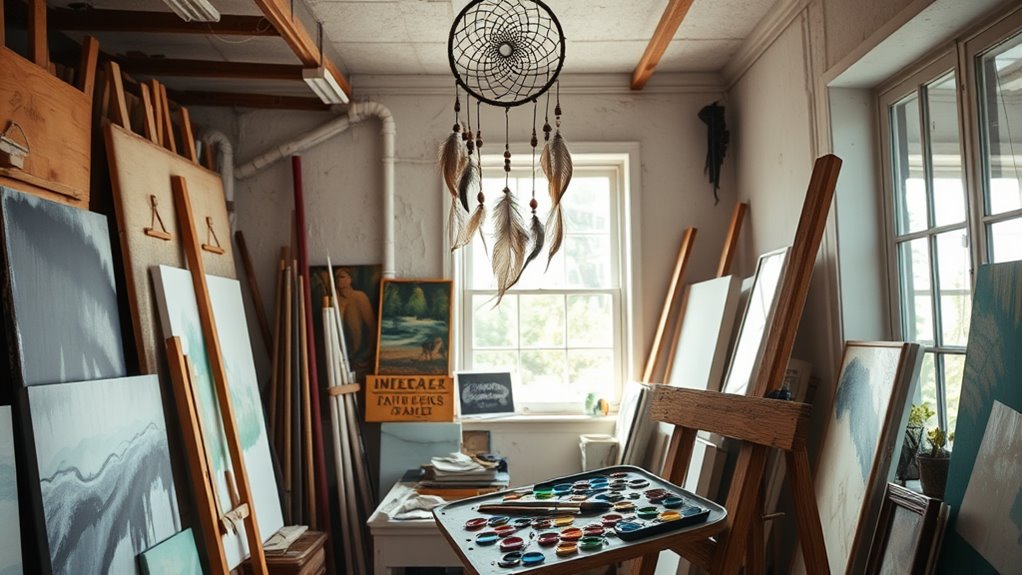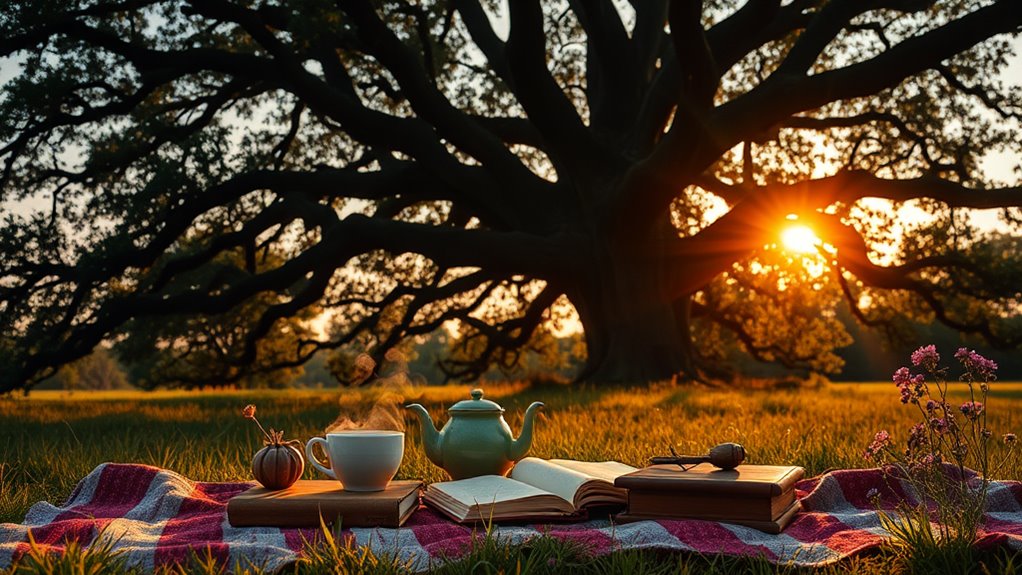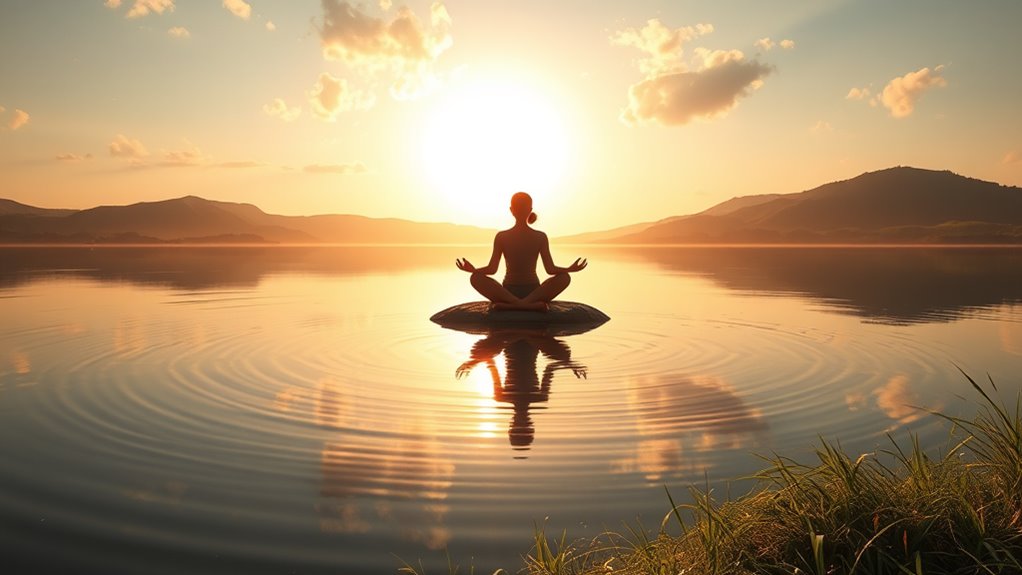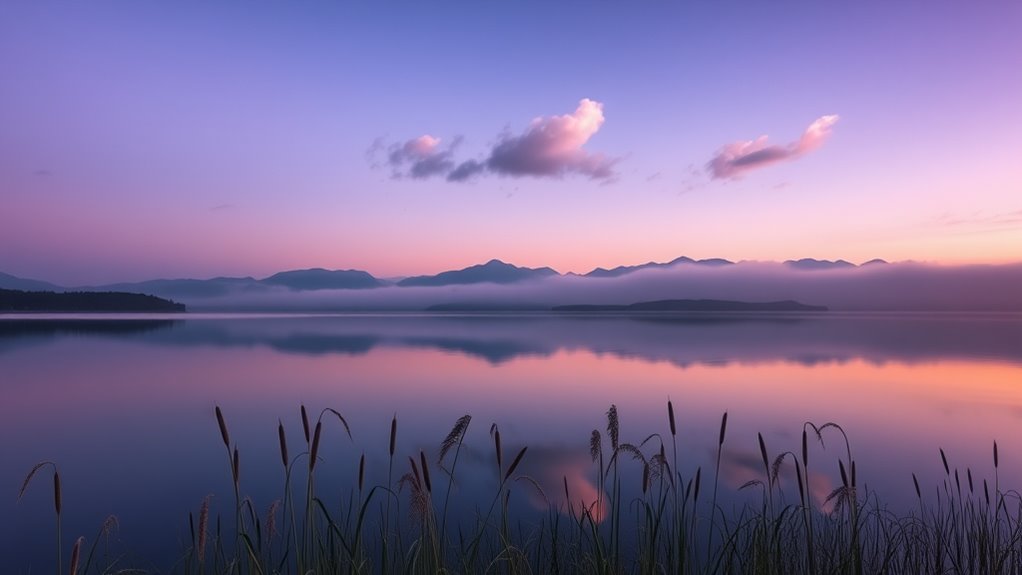Unlock Your Creative Potential With These Visualizations!
Tap into your creative potential with powerful visualizations! Start with mind mapping to lay out your ideas visually, enhancing understanding and connection. Embrace guided imagery to spark new, unique solutions by envisioning different scenarios. If you’re feeling blocked, integrate your dreams into your creative process; they’re a goldmine for untapped ideas. Why not try some color psychology to set the mood? Exploring these techniques could lead you to discover even more innovative pathways.
Key Takeaways
- Utilize mind mapping to visualize relationships and generate complex, innovative ideas effectively.
- Engage in guided imagery to explore serene landscapes mentally and uncover unique solutions.
- Create a vision board to visually reinforce and continually inspire your creative goals.
- Employ dream integration techniques to tap into subconscious insights for breakthrough ideas.
- Incorporate colors associated with creativity, like blue, in your workspace to stimulate innovative thinking.
The Power of Mind Mapping for Idea Generation
While many people struggle with generating new ideas, mind mapping can be a game changer for releasing your creative potential. This visual tool amplifies your ability to generate diverse thoughts and connect them in meaningful ways.
Here’s how you do it: Start with a central concept, then branch out into related ideas, each represented with a keyword or image. This spatial arrangement helps you see relationships and potential combinations that you might miss in linear notes.
Leveraging this technique stimulates your brain to operate both analytically and creatively, offering a substantial creativity boost.
You’ll soon find yourself unveiling intricate solutions and innovative ideas that appeared elusive before. Embrace mind mapping to transform your thought process and elevate your idea generation prowess.
Using Guided Imagery to Inspire New Concepts
After exploring mind mapping, let’s delve into how guided imagery can unleash your creative brilliance.
Imagine closing your eyes and transporting yourself to a serene landscape. You’re not just observing; you’re actively engaging with your environment. This practice isn’t just for relaxation—it’s a potent tool for conceptualization.
Guided imagery propels you beyond traditional boundaries, encouraging a vivid exploration of ideas and scenarios that mightn’t surface in a typical brainstorming session. By mentally simulating experiences, you can uncover unique solutions and innovative approaches that are otherwise obscured by conventional thinking.
Start by visualizing a problem you’re tackling. Let your mind wander through different environments and interactions. What unexplored concepts can you bring back to reality from this creative journey?
Incorporating visualization techniques that enhance your manifestation practice also allows you to connect deeper with your subconscious, setting a powerful foundation for creative insights.
Dream Integration Into Your Creative Process
Integrating dreams into your creative process can open up a reservoir of untapped ideas. You’re not just sleeping; you’re unconsciously exploring possibilities. Here’s a practical way to harness these visions:
| Step | Action | Benefit |
|---|---|---|
| Record | Immediately jot down dream details. | Captures raw, unfiltered content. |
| Analyze | Look for symbols and patterns. | Identifies underlying themes. |
| Connect | Link dream elements to your project. | Bridges the abstract and concrete. |
| Experiment | Apply insights in small tests. | Gauges viability of ideas. |
| Reflect | Assess the impact on your work. | Refines and integrates findings. |
Creative visualization is not just a method, but a practice that transforms lives(/examples) by fostering a deeper connection with internal thought processes and enhancing creativity.
Employing Synectics for Innovative Thinking
Employing synectics in your creative toolkit can significantly elevate your innovative thinking. It’s about making the familiar strange and the strange familiar, mixing elements you mightn’t usually combine. Think of it as your mind’s cross-fit; challenging, yet immensely rewarding.
-
Imagine metaphoric bridges: Picture constructing bridges from concrete ideas to abstract ones, linking unrelated concepts to spark that ‘aha’ moment.
-
Role play scenarios: Step into others’ shoes, like a musician or a scientist, to see how they might solve your problem, elevating your perspective and creativity threshold.
-
Analogies as a flashlight in the dark: Use analogies to illuminate connections that aren’t immediately obvious, guiding your thought pattern in unexplored directions.
Master these techniques, and you’ll unlock complexities in problems quicker and more creatively.
Visualizations not only enhance memory retention but also promote innovative problem-solving, making them essential tools in any creative endeavor.
Color Psychology: Visualizing to Stimulate Creativity
While exploring creative processes, consider how color psychology can amplify your capacity for innovation. Colors aren’t just aesthetic choices; they’re tools that can influence your mood and cognitive functions. For instance, blue often sparks creativity, making it ideal for brainstorming sessions. On the other hand, yellow stimulates optimism, fostering a positive environment to generate and nurture new ideas. To harness this power, visualize your workspace enveloped in these hues—picture a serene blue wall or vibrant yellow accents. This isn’t just about decoration; it’s about creating an environment that subconsciously guides your thoughts and emotions towards more innovative pathways. Additionally, incorporating visualization techniques can further enhance your environmental and mental preparation, aligning your creative vision with productive outcomes.
Establishing a Vision Board for Continuous Inspiration
After exploring how color can enhance your creative process, you might also consider setting up a vision board to keep that inspiration flowing. A vision board isn’t just any collage; it’s a powerful visualization tool that concretizes your aspirations and keeps your creative energies activated.
To craft an effective vision board:
-
Gather images that resonate with your goals—vivid, evocative visuals that stir your spirit and sharpen your focus.
-
Incorporate motivational quotes and affirmations that align with your vision, reinforcing your path with positive self-speak.
-
Choose a prominent display location where you’ll see your vision board daily, ensuring it’s both a subconscious and conscious trigger of your creative ambitions.
Harness this visual synergy to continuously fuel your creative journey. Creative visualization techniques not only boost creativity but also enhance mental clarity, making everyday challenges more manageable and inspiring innovative responses.
Sculpting Your Mental Landscape With Meditation Visuals
As you delve into the realm of meditation, consider using visuals to sculpt your mental landscape. This technique isn’t just about relaxation; it’s a strategic tool to enhance your creativity. Imagine your mind as a malleable terrain. Each visualization acts like a sculptor’s hands, shaping and refining thoughts and ideas with precision.
Visualize a garden where each flower represents a project or idea. Tend to this garden daily, pruning the unnecessary and watering the promising. Over time, this mental imagery becomes second nature, allowing you to access and expand your creative reserves effortlessly.
Incorporate vivid, dynamic images that resonate personally. These mental sculptures will anchor your thoughts, making the abstract tangible and the impossible achievable. Focus, refine, and watch your creative landscape flourish.
Adopting the SCAMPER Technique for Creative Insights
To further unlock your creative potential, consider adopting the SCAMPER technique, a series of guided questions that inspire innovation and problem-solving.
SCAMPER, an acronym that identifies different ways you can transform ordinary concepts into extraordinary solutions, stands for Substitute, Combine, Adapt, Modify, Put to another use, Eliminate, and Reverse.
Mastery of SCAMPER enables you to systematically dissect and re-envision products, services, or processes.
Here’s how you might visualize its impact:
- Substitute: Envision swapping a component in your product with something unconventional, sparking a novel feature.
- Combine: Picture merging two ordinary services to create a superior, hybrid solution.
- Adapt: Imagine morphing an existing solution to work under new conditions, uncovering untapped markets.
Embrace these techniques to redefine boundaries and lead in innovation.
Harnessing the Role of Nature Views in Creative Enhancement
You’ve likely noticed how a stroll through a park can refresh your mind and spark new ideas.
Exploring how nature’s vistas impact creativity reveals that outdoor spaces do more than just inspire; they transform our approach to problem-solving.
Incorporating elements of biophilic design into your workspace can also enhance creative output by connecting you closer to the natural world.
Nature’s Impact on Creativity
While many factors contribute to sparking creativity, immersing yourself in nature can remarkably enhance your innovative abilities. The diverse patterns in leaves, the fluidity of rivers, and the vast expanse of the sky serve as a canvas that invites you to explore new possibilities.
Picture this:
-
The rhythmic dance of branches in the wind creates a flow that can translate to fluid thinking in your projects.
-
The kaleidoscope of colors at sunset inspires innovative color palettes and design ideas you’ve never considered before.
-
The intricate patterns of frost on a leaf challenge you to think about complexity and simplicity in your work, fostering a deeper understanding of balance.
Harness these elements from nature to expand your creative horizons significantly.
Outdoor Spaces Inspire Ideas
Have you ever noticed how a simple view from your window or a walk through a park can suddenly flood you with fresh ideas? It’s not just a coincidence. Natural environments stimulate creative processes in your brain. To harness this, integrate regular outdoor engagements into your routine.
| Nature Aspect | Creative Influence |
|---|---|
| Water scenes | Evokes fluidity in thoughts |
| Green landscapes | Enhances relaxation, leading to improved problem-solving |
| Diverse flora | Introduces novel patterns, boosting innovative thinking |
| Sky views | Expands thinking, prompting broad vision |
Biophilic Design Benefits
Many workplaces are embracing biophilic design, integrating natural elements into building architecture to enhance creativity and productivity among employees.
You’ll find that this approach isn’t just refreshing—it’s transformative. By deliberately incorporating aspects of nature into your work environment, you’re not merely decorating; you’re fortifying your mental and creative faculties.
-
Verdant Living Walls: Imagine vibrant green walls alive with lush foliage that not only increase oxygen levels but also your connection to nature, reducing stress and fostering relaxation.
-
Natural Light Abundance: Large, clear windows not only illuminate your space but also provide a scenic view that can reset your cognitive function and boost your mood.
-
Water Features: Subtle sounds of flowing water can heighten concentration and induce a serene environment, facilitating deeper thought and innovation.
Embrace these elements to significantly uplift your creative output.
Frequently Asked Questions
How Long Do Visualizations Typically Take to Enhance Creativity?
You’ll find that visualizations can enhance your creativity in as little as a few weeks. Regular practice, ideally daily, maximizes their effectiveness, helping you achieve profound mastery in your creative endeavors.
Can Visualizations Help Overcome Writer’s Block?
Yes, visualizations can break through your writer’s block, juxtaposing barren ideas with fertile creativity. They’ll transport you into vivid scenarios, helping you generate fresh perspectives and original concepts, essential for your mastery in writing.
What Is the Best Time of Day for Creative Visualizations?
The best time for creative visualizations is when you’re most alert and relaxed—often early morning or late evening. You’ll find your thoughts flow easily at these times, enhancing your visualization effectiveness.
Are There Specific Apps That Assist With Creative Visualizations?
Certainly, apps like Headspace and Calm serve as powerful tools, opening the door to enhanced creative visualizations. They offer guided imagery that can sharpen your mental imagery, boosting your creativity and visualization skills.
How Often Should I Practice Visualizations for Optimal Creativity?
For optimal creativity, you should practice visualizations daily. Dedicating even just 10-15 minutes can significantly enhance your creative thinking and problem-solving abilities, setting the foundation for mastery in your creative pursuits.





